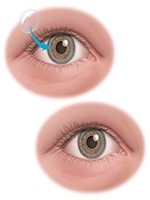The cornea, the clear covering of the front of the eye, is designed to both transmit and focus light rays as they enter the eye. There are many diseases that can affect the cornea, causing pain or loss of vision. Disease, infection or injury can cause the cornea to swell, known as edema, or degrade the cornea to the point that vision diminishes. Because the cornea must remain transparent to optimize vision, it contains no blood vessels, receiving its nourishment from tears and the aqueous humor, the fluid found in the anterior portion of the eye.

Function and Structure of the Cornea
The cornea serves as a shield, protecting the eye from invasion by dust and harmful organisms. Like a window, the cornea receives and focuses light as it enters. In addition, the cornea provides a filter, keeping out some the most dangerous ultraviolet (UV) rays. Without the cornea, the eye would be more vulnerable to sun damage, as well as to infection and inflammation.
The cornea is comprised of several layers, each made up of slightly different cells and each performing a somewhat different function. These layers are:
- Epithelium
- Bowman's layer
- Stroma
- Descemet's membrane
- Endothelium
While the cornea responds well to minor injuries, replacing damaged cells with healthy ones, deep scratches or abrasions can be serious, resulting in severe pain and affecting vision. Extreme pain, tearing, eye redness, sensitivity to light, and vision loss can also result from various eye conditions and diseases. When such symptoms occur, consultation with an ophthalmologist is required for professional diagnosis and treatment. Where corneal scarring has taken place, a corneal transplant may be necessary.
Diseases of the Cornea
Common diseases and disorders that affect the cornea include:
- Corneal trauma (scratches, abrasions, lacerations, foreign body removal)
- Dry Eye
- Corneal dystrophies, such as Fuch's Endothelial dystrophy, Map Dot Fingerprint Dystrophy (EBMD), or Granular Dystrophy
- Corneal swelling (bullous keratopathy)
- Recurrent Corneal Erosion Syndrome
- Corneal and conjuctival tumors
- Corneal ulcers and infections
- Keratoconus
- Herpetic eye disease (HSV, Varicella Zoster, Shingles)
Injuries, such as allergies, chemical irritations, abrasions, over exposure to light, or getting dust or small objects in the eye, may make the cornea more vulnerable to infection or disease.
Treatment of Corneal Disease
Treatment for corneal disease can take many forms, depending on the underlying problem and the patient's medical history. Some conditions may resolve on their own and many can be treated with medication. If the cornea is severely damaged or if there is a risk of blindness, a corneal transplant may be recommended to preserve vision.
There are several types of corneal transplant procedures available, including:
- DSAEK (Descemet's Stripping Automated Endothelial Keratoplasty)
- DMEK (Descemet's Membrane Endothelial Keratoplasty)
- DALK (Deep Anterior Lamellar Keratoplasty)
- PK (Penetrating Keratoplasty or full thickness corneal transplant)

At times, complex cataract surgery may be performed simultaneously during a corneal transplant.
Other types of related corneal surgery include:
- Microsurgical ocular reconstruction (intraocular lens exchange or repair, iris/pupil repair, or release of scarring)
- Corneal collagen crosslinking (CXL) for keratoconus or post LASIK ectasia
- Pterygium surgery
Other surgical procedures, such as sutured intraocular lenses, repair of subluxed lenses, or the implantation of an artificial iris, may also be necessary.

